Plan Drawings for Single Rafter Porch
Expert communication on how to adhere a patio roof to a house, with stride-past-footstep instructions and construction diagrams.
A business firm-attached patio roof takes advantage of the house'south structure by supporting one end of the roof on a ledger mounted horizontally to the house. The ledger, typically a 2 by six, is usually designed to hold one stop of the patio-roof rafters. Locating and mounting the ledger is unremarkably a fairly easy procedure; the ledger should exist fastened earlier the foundation is built for a deck, patio roof posts, and other construction.
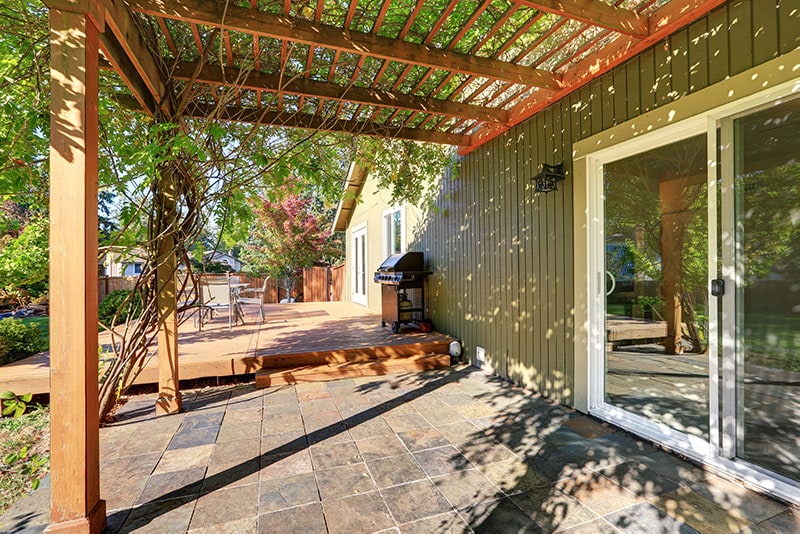
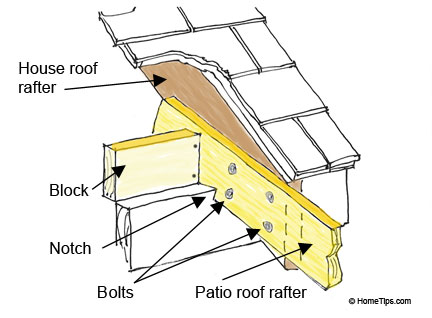
Where to Attach a Patio Roof Ledger
On a one-story house, it is often best to adhere the ledger for a patio roof just beneath the business firm's eaves.

On a two-story firm, you can ordinarily tie the ledger into a band joist (besides called a rim joist), located between the floors, as shown below. Notice the ring joist by measuring down from a 2d-story window.
Mounting the Patio Roof Ledger
Procedures for mounting a ledger depend on the type of siding on the house. Relatively apartment siding can remain intact, but clapboard, beveled wood, metallic, or vinyl siding should e'er be cut away.
If you have beveled horizontal siding, then use an inverted piece of siding, every bit shown in the illustration here, to create a plumb, apartment surface for attaching the ledger.
If your siding is non askew, you can merely screw the ledger tightly to it.
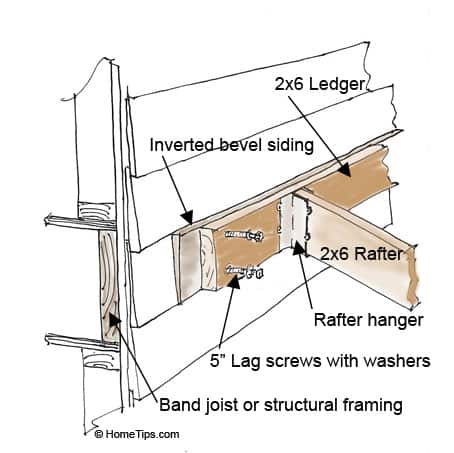
Remove enough of the siding so y'all tin tuck flashing behind the siding above the ledger and allow information technology to overhang the siding below the ledger.
When cut wood siding, adjust the blade of the circular saw and so it cuts just the siding and non the capsule underneath. Likewise, do non let the blade cutting across the layout lines. If you are cut vinyl siding, you lot can utilize a sharp utility knife instead.
A ledger should be affixed to strong parts of the business firm's framing, such as second-floor joists or wall studs. The strongest ledger connection relies on bolts that run through the ledger and the house capsule and rim or band joist and and so are fastened with basics and washers affixed from the other side. When access to the other side is unfeasible, employ lag screws with washers instead of bolts, as shown in the illustration.
If it is impossible to attach the ledger to a floor joist, then fasten the ledger to wall studs, which are generally located on 16-inch (or sometimes 24-inch) centers and doubled up around doors, windows, and other openings.
Temporarily blast or brace the ledger in place, positioned and leveled at the desired summit. Re-check for level, and then drill lag-spiral or bolt airplane pilot holes through the ledger and into the house's framing.
Attach the ledger with i/2-inch-diameter lag screws or bolts every xvi inches (or as specified by local building codes).
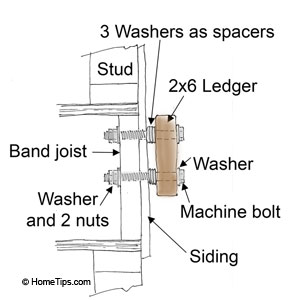
Slip three or 4 stainless-steel washers between the ledger and the siding when driving each screw, equally shown at left. This will allow water to menstruum behind the ledger.
If attaching a patio roof to a ledger below the eaves does not permit for enough headroom, you can fix the new patio roof'due south rafters on the wall'south top plate and fasten them to the sides of the house rafters, as shown in the cutaway drawing higher up.

+

Local Patio Roof Construction Pros
Fastening to Masonry Walls
Anchor a ledger to a masonry wall with expanding ballast bolts. Brainstorm by marking a line across the wall for the ledger'due south elevation border. Drill holes for the expanding anchors every 16 inches or as specified past local codes, insert the anchors, hold the ledger in identify, and tap it with a hammer to indent the ballast locations on its back face up.
Remove the ledger, and drill commodities holes where the commodities tips have left marks. Push button or hammer the ledger back onto the bolts, recheck for level (making any needed adjustments), add washers and nuts, and so tighten the bolts.
Flashing a Patio Roof Ledger
Unless it will exist protected from rain past the firm's eaves or a solid roof, a roof ledger that is fastened directly to a house with wood siding should exist capped with galvanized metal Z-flashing that tucks up nether siding to forbid water from seeping in backside information technology.
Where integral flashing isn't possible, such every bit on a stucco wall, utilize Z-flashing and caulk the top edge. This is a job you must do before fastening the overhead's roof rafters in place.
Y'all can buy 50- or Z-shaped flashing or bend information technology yourself. To bend sheet-metallic flashing, make a form past clamping two ii past 4s together on each side of the metal, and then hammer the metal to create a precipitous edge at each fold. (The result is much neater if you buy pre-formed flashing.)
Fit the flashing in place, caulk the acme edge, and blast information technology with galvanized nails long enough to penetrate at least ane inch into the structural members. Then caulk the smash heads.
If the firm is sided with shingles or lap siding, simply sideslip the metal'southward top border up under the bottom border of the shingles or siding as far as possible.
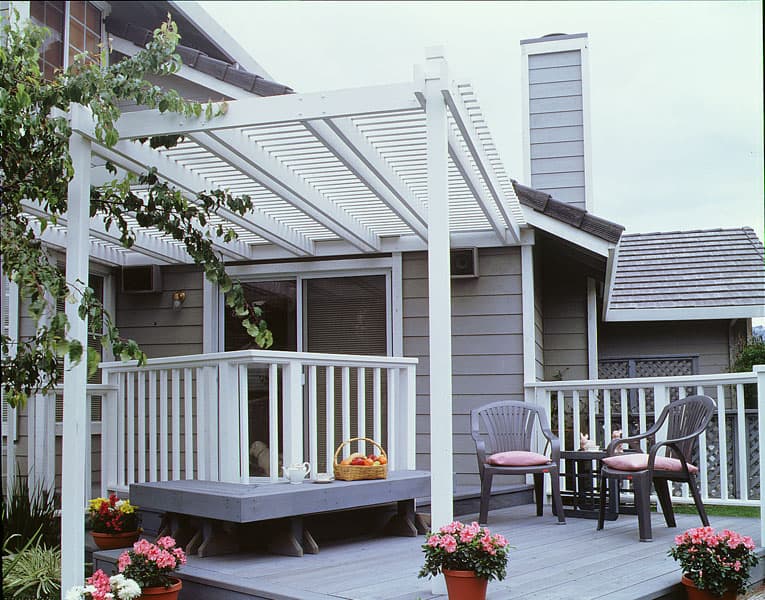
Next Meet:
- Building a Roof Over a Deck or Patio
- Siting a Patio Roof
- Erecting Patio Roof Posts
- Cut Posts & Lifting Beams
- Installing Patio Roof Rafters
- Batten & Board Patio Roofing
If building a patio roof or gazebo yourself is sounds similar more than you want to tackle, please see our affiliate partner, HomeAdvisor.
![]()
Source: https://www.hometips.com/diy-how-to/patio-roof-attach.html
0 Response to "Plan Drawings for Single Rafter Porch"
Post a Comment